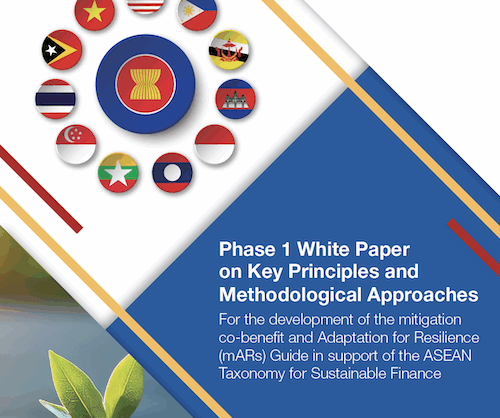UNEP FI has supported the development of the “Phase 1 White Paper on Key Principles and Methodological Approaches for the development of the mitigation co-benefit and Adaptation for Resilience (mARs) Guide in support of the ASEAN Taxonomy for Sustainable Finance” for the ASEAN Capital Markets Forum (ACMF). It is the first output of the recently announced partnership with ACMF and Sustainable Finance Institute Asia (SFIA) to help the ASEAN region leverage its Sustainable Finance Taxonomy to enhance its usability and functionality for adaptation-specific purposes, with the aim of mobilizing finance.
About the white paper
Southeast Asia is already experiencing the effects of climate change, with more frequent and intense weather events, rising sea levels, and increasing temperature extremes—threatening livelihoods, food security and public health. These climate threats are compounded by high population densities, economic reliance on climate-sensitive sectors such as agriculture and fisheries, and widespread coastal and urban vulnerabilities, making ASEAN one of the most at-risk regions globally.1 Combined, these factors underscore the increasingly central role of adaptation to climate change in managing climate risk, both globally and within the ASEAN context.
Climate finance needs in the ASEAN region are estimated at approximately USD 422 billion per year by 2030, of which USD 129 billion per year is specifically needed for climate adaptation.2 Despite growing recognition of the importance of adaptation, financing remains limited and predominantly sourced from public funds and multilateral development banks, with significant challenges remaining for mobilizing finance from private finance, with particular barriers posed by uncertainties around the bankability of adaptation investments.3
As adaptation and resilience finance demands increase, the ASEAN region needs to leverage its Sustainable Finance Taxonomy to enhance its usability and functionality for adaptation-specific purposes, which in turn can catalyze investments.
The white paper:
highlights how current adaptation financing flows in the ASEAN region fall significantly short of estimated adaptation investment needs,
explores how the rapid developments related to sustainable finance taxonomies in the region provide an important opportunity to create new means of mobilizing finance for adaptation,
details the methodological approach for the development of the forthcoming mARs Guide, and
proposes for discussion a set of key principles for the mARs Guide, which complement the existing Five Core Principles of the ASEAN Taxonomy.
1 UNFCCC and ASEAN Secretariat, Climate Finance Access and Mobilization Strategy for the Member States of the Association of Southeast Asian Nations (2024-2030), December 2024
2 Ibid.
3 UNEP, Adaptation Gap Report 2024, November 2024
